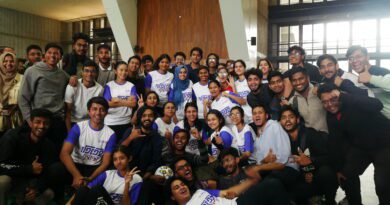Midnight’s Third Child: A Discussion on Everything that is Fleeting.
On June 11th, Brac University’s Departments of Architecture, English and Humanities and Economics and Social Sciences jointly organized a book launch for Naeem Mohaiemen’s latest essay collection Midnight’s Third Child. Tackling the fleeting sense of belonging and misrecognition within the South Asian postcolonial experience, Mohaiemen is a filmmaker, photographer and essayist. Present at the event were BracU’s very own Dr Seuty Sabur and Dr Tabassum Zaman of the Departments of Economics and Social Sciences and English and Humanities respectively as discussants, in addition to the author himself.
Beginning as articles for various Bangladeshi newspapers, the collection was written over a period of 15 years; perfectly encapsulated in its cover portraying a filming crew from 1986. Initiating the discussion, Mohaiemen highlights the significance of the book’s title: Midnight’s Third Child; a play on Salman Rushdie’s Midnight’s Children referring to Jawaharlal Nehru’s infamous speech on the eve of India’s independence, “At the stroke of midnight, a new nation is born.”
Divided into two sessions, the event commenced with segments from Tareque Masud’s The Inner Strength, a film based on artist S.M. Sultan, and Rubaiyat Hossain’s Meherjaan followed by a number of Abir Shome and Razib Datta’s artworks. Each piece was followed by Mohaimen reading excerpts from his book referring to his individual and the general public’s reaction to them. For the audience, Mohaiemen crafted a thoroughly captivating atmosphere through his narration, encouraging them to read the book themselves.
The following session began by introducing Dr Sabur and Dr Zaman to share their thoughts and opinions regarding Mohaiemen’s book. Dr Zaman, the first to speak, compliments the author on the manner he penned his book, highlighting the significance and implications of its unique methodology; something she believes to be lacking in academia. To follow, Dr Sabur mentions how inspired she had been by Mohaiemen’s methodology and her plans to write about it in a future book; discussing his concerns with the trivial details in art and history and his ability to unite various people and their stories within Midnight’s Third Child.
As a response, Mohaimen states how protests and unfinished works by various artists have been a fundamental part of our upbringing; that Bangladesh was in a cultural crisis and that more should be done to make our history more accessible. Through his work, Mohaimen wishes to encourage people to think creatively, distancing themselves from being overtly consumed by today’s flattened media. The event concluded with Mohaimen giving students the opportunity to discuss their thoughts, observations and questions.




